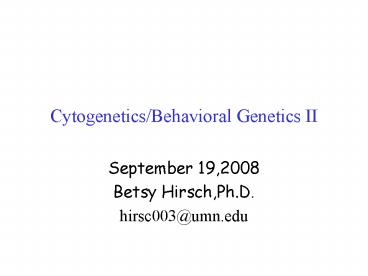CytogeneticsBehavioral Genetics II PowerPoint PPT Presentation
1 / 47
Title: CytogeneticsBehavioral Genetics II
1
Cytogenetics/Behavioral Genetics II
- September 19,2008
- Betsy Hirsch,Ph.D.
- hirsc003_at_umn.edu
2
(No Transcript)
3
(No Transcript)
4
Fragile X-Associated Tremor/Ataxia Syndrome
(FXTAS)
- Affects approximately 30 of premutation male
carriers - Adult onset progressive tremor and ataxia
- Attributed to over-expression of FMR1 mRNA (5
fold to 8 fold) rather than to the decreased
levels of FMRP
5
Female Carriers of Premutation
- Overexpression of mRNA
- Approximately 20 of female premutation carriers
have premature ovarian failure (lt age 40 yrs)
6
Supplemental References
- Garber et al, 2008, Fragile X syndrome, European
Journal of Human Genetics 16666-672 - Koukoui SD and Chaudhuri A, 2007,
Neuroanatomical, molecular genetic, and
behavioral correlates of Fragile X syndrome,
Brain Research Reviews 5327-38
7
Microdeletion/Microduplication Syndromes
- Typically involve loss or gain of a portion of
one G-band, generally involving approximately 2-3
Mb of DNA - Can be very difficult to detect even by high
resolution G-banding - Most frequently diagnosed and characterized by
FISH
8
Fluorescence-in-situ-hybridization(FISH)
- Technique in which a DNA probe containing one or
more genes (or a small chromosomal region) is
labeled with a fluorescent dye, and then
hybridized to interphase or metaphase cells - Use to detect small regions of deletions or
duplications - Used to examine specific regions of the genome in
non-dividing tissues - Used to map genes
9
(No Transcript)
10
18 FISH
11
Microdeletion Deletion Syndromes
- Williams syndrome (7q11.2)
- Prader-Willi / Angelman syndrome (15q11.2)
- Smith Magenis syndrome (17p11.2)
- DiGeorge/Velocardiofacial syndrome (22q11.2)
12
(No Transcript)
13
P-W comp 15
14
(No Transcript)
15
P-W FISH
16
(No Transcript)
17
Prader-Willi / Angelman Syndromes
- In 70 of cases of PWS and AS, apparently
identical deletions of 15q11.2 are detected - Deletion encompasses 3.5 megabases of DNA
- 10 genes have been identified within this
deleted region
18
Prader-Willi Syndrome
- Deletions are always of paternal origin
- Putative PWS genes are expressed exclusively on
the paternally derived homolog - Example of genomic imprinting
19
Prader Willi Syndrome
- As more than one gene within the deleted region
shows such a paternal expression pattern, PWS may
be a contiguous gene disorder
20
Deletions may result in clinical syndromes
because
- Single putative gene is contained within the
deleted region - or
- Several contiguous genes, each contributing some
aspect of the phenotype, are contained within the
deleted region
21
22
Angelman Syndrome
- Deletions are always of maternal origin
- A single putative AS gene, UBE3A, has been
identified, which is expressed in brain tissue
exclusively from the maternally derived homolog
(biparental expression of UBE3A has been shown in
other tissues)
23
(No Transcript)
24
Paternal
Maternal
25
Paternal
Maternal
26
Imprinting must be a reversable processMust be
able to be reset when passed from
father-gtdaughter-gtgrandchild ormother -gtson-gt
grandchild
27
Uniparental Disomy in PWS
- In 28 of PWS cases, the syndrome is caused not
by a deletion, but by maternal uniparental disomy
for chromosome 15
28
Uniparental Disomy
- Both chromosomes of a given chromosome pair are
inherited from ONE parent - Most likely generated by an initial
non-disjunction event leading to trisomy,
followed by loss of one of the trisomic
chromosomes and restoration of a disomic state
trisomic rescue
29
(No Transcript)
30
(No Transcript)
31
(No Transcript)
32
Genotype/Phenotype Correlations
- Microdeletions typically associated with
specific constellation of clinical findings, - e.g. Williams syndrome, DiGeorge Syndrome,
Prader Willi syndrome - Microduplications less likely to be
associated with specific clinical syndrome
however, have been associated with developmental
disabilities, autism spectrum disorders
33
a-CGH
- Methodology for scanning the genome for regions
of gain or loss - (duplications, deletions, trisomy, monosomy)
34
Array-CGH
Control Genomic DNA
Patient Genomic DNA
Restrict Quantify, Label with different
fluorochromes
Combine in 11 Ratio
Hybridize to chip onto which DNA probes have
been spotted
35
SCAN and ANALYZE
36
Our 44K chip
37
Raw
Ratio equals 0 no copy number gains or losses lt
0.3 Loss (Deletion) gt 0.3 Gain (Duplication)
38
10 oligos within a 1 Mb region
39
Start point 15,443,578 Stop point
17,021,468 Size 1,577,890 bp
CESK1 XKR3 GAB4 IL17RA CECR6 CECR5 CECR1 SLC25A18
ATP6V1E1 BCL2L13 BID PEX26 TUBA8 USP18
40
(No Transcript)
41
Copy Number Variants
- In 2004, another level of variation in the human
genome was demonstrated - Differences in the number of copies of a given
sequence - (versus base pair composition of the sequence)
- Iafrate et al (Nature Genetics) and Sebat
et al (Science)
42
CNV
- DNA segment 1Kb or larger
- Has a variable copy number compared with a
reference genome - Current Estimates
- 5000 CNV loci encompassing approximately 6 Mb
of the genome (range 5 24 Mb) - http//projects.tcag.ca/variation
- http//paralogy.gs.washington.edu/structuralvariat
ion
43
Not all copy number gains or losses are
clinically significant
44
10 oligos within a 1 Mb region
45
Well documented CNV in healthy control populations
(17/95 controls had loss)
46
ADM-2
22q13.33 loss Start point 49427512 Stop point
49525130 Size 98 Kb Genes SHANK3 (14 kb in
size) ACR
SHANK3
47
New York Times, December 28,2007

